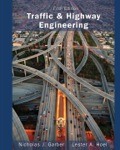
Concept explainers
(a)
Time mean speed.
Answer to Problem 1P
The time mean speed is
Explanation of Solution
Given:
Observers stationed at two sections XX and YY, 500 ft apart on a highway, recording the time of vehicles on their arrival as shown in the accompanying table
The total time of observation at XX was 15 sec.
In order to calculate time mean speed, we need to figure out traveling time of each vehicle which is the difference of time taken by a vehicle in travelling from XX to YY section between the two sections.
Calculation:
| Vehicles | Section XX | Section YY | Travelling time of vehicle, |
| A | | | |
| B | | | |
| C | | | |
| D | | | |
We have the following formula for the time mean speed:
Where,
n is the number of the vehicles passing.
Now, the speed of the individual vehicles is as follows:
Speed of vehicle A:
Speed of vehicle B:
Speed of vehicle C:
Speed of vehicle D:
Now, the time mean speed can be calculated by substituting the values in the following formula:
Conclusion:
Therefore, the time mean speed is
(b)
Space mean speed.
Answer to Problem 1P
The time mean speed is
Explanation of Solution
Given:
Observers stationed at two sections XX and YY, 500 ft apart on a highway, recording the time of vehicles on their arrivalas shown in the accompanying table.

The total time of observation at XX was 15 sec.
Calculation:
We have the following formula for finding out the space mean speed.
Where,
Substitute the values, we have:
Conclusion:
Therefore, the time mean speed is
(c)
Flow at section XX.
Answer to Problem 1P
The flow at section XX is as follows
Explanation of Solution
Given:
Observers stationed at two sections XX and YY, 500 ft apart on a highway, recording the time of vehicles on their arrival as shown in the accompanying table.

The total time of observation at XX was 15 sec.
Calculation:
We have the following formula for finding out the flow at XX section.
Where,
Substitute the values, we have:
Conclusion:
Therefore, the flow at section XX is as follows
Want to see more full solutions like this?
Chapter 6 Solutions
Traffic and Highway Engineering
- Draw the shear and the moment diagrams for each of the frames below. If the frame is statically indeterminate the reactions have been provided. Problem 1 (Assume pin connections at A, B and C). 30 kN 2 m 5 m 30 kN/m B 60 kN 2 m 2 m A 22 CO Carrow_forwardThis is an old exam practice question. The answer key says the answer is Pmax = 52.8kN but I am confused how they got that.arrow_forwardF12-45. Car A is traveling with a constant speed of 80 km/h due north, while car B is traveling with a constant speed of 100 km/h due east. Determine the velocity of car B relative to car A. pload Choose a File Question 5 VA - WB VBA V100 111413 + *12-164. The car travels along the circular curve of radius r = 100 ft with a constant speed of v = 30 ft/s. Determine the angular rate of rotation è of the radial liner and the magnitude of the car's acceleration. Probs. 12-163/164 pload Choose a File r = 400 ft 20 ptsarrow_forward
- P6.16 A compound shaft (Figure P6.16) consists of a titanium alloy [G= 6,200 ksi] tube (1) and a solid stainless steel [G= 11,500 ksi] shaft (2). Tube (1) has a length L₁ = 40 in., an outside diameter D₁ = 1.75 in., and a wall thickness t₁ = 0.125 in. Shaft (2) has a length 42 = 50 in. and a diameter d₂ = 1.25 in. If an external torque TB = 580 lb ft acts at pulley B in the direction shown, calculate the torque Tcrequired at pulley C so that the rotation angle of pulley Crelative to A is zero. B Te (2) TB (1) FIGURE P6.16arrow_forward7.43 Neglecting head losses, determine what horsepower the pump must deliver to produce the flow as shown. Here, the elevations at points A, B, C, and D are 124 ft, 161 ft, 110 ft, and 90 ft, respectively. The nozzle area is 0.10 ft². B Nozzle Water C Problem 7.43arrow_forwardA 1.8m x 1.8m footing is located at a depth of 1 m below the ground surface in a deep deposit of compacted sand (f'= 33 , f' = 28 , γ = 17.5 kN/m). Calculate the ultimate net bearing capacity considering several factors (e.g., shape, depth, and inclination) when the groundwater table is located (a) at 5 m below the footing base, (b) at the ground surface, (c) at the footing base, and (d) at 1.5 m below the footing base. Also, explain the effects of the groundwater levels in the bearing capacities of the footing with your own words. If the information is not given for the calculation, please assume it reasonably.arrow_forward
 Traffic and Highway EngineeringCivil EngineeringISBN:9781305156241Author:Garber, Nicholas J.Publisher:Cengage Learning
Traffic and Highway EngineeringCivil EngineeringISBN:9781305156241Author:Garber, Nicholas J.Publisher:Cengage Learning
